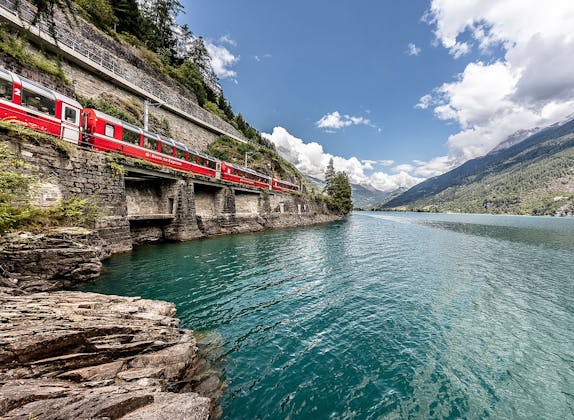
Swiss Travel Pass
Validity: All day

Are you travelling to Switzerland for five days in Switzerland and are looking for your perfect itinerary? In this case, this selection of 10 itineraries will help you plan your trip. You’ll find different options for your five-day trip starting in Zurich. All of the following itineraries are also adaptable so that you can start somewhere along the way or in a completely different city.
Five days is a good amount of time for a trip through Switzerland, especially if you’ve never been here and want to get a feel for this beautiful country. You’ll have enough time to see different places without rushing too much. If you’re planning your trip to Switzerland, the following routes will help you out.
They’re all doable in five days, starting from Zurich. However, if you’d prefer to start from a different location, you can easily adjust your trip accordingly. Zurich is very well connected and can be reached from any other city in Switzerland.
You’ll notice that we’re only talking about travel by public transportation rather than by car. Most routes can also be driven, in case you want to rent a car during your stay in Switzerland. But with our very dense network of trains and buses, traveling by car is actually unnecessary.
And if you have more than three days and see a route you like, you can easily extend it by spending an extra night in some places.
Have fun planning!

Highlights on this route:
Explore Zurich on your own in the morning, rent a free bike with "Züri rollt" or join a city tour. After the tour, grab a take-away lunch and take the train to Bellinzona.
Thanks to the 57 km long Gotthard Base Tunnel, you'll now take less than two hours to zoom through the Alps and reach the warm south of Switzerland.
Make a stop in Bellinzona to visit the Castello di Montebello, a UNESCO World Heritage site, before continuing on to Locarno.
Spend the rest of the evening enjoying the Italian vibe in Locarno. Hang out at the Piazza Grande, stroll along Lake Maggiore, or treat yourself to some ice cream by the lake. And just in case you’re wondering: yes, you’re still in Switzerland. Even if it feels more like Italy.
Since you'll be spending the next two nights in Ticino, you're eligible for the fantastic Ticino Ticket. You'll get it when you check into your accommodation.
This handy guest card allows you to use public transport throughout Ticino for free. Plus, you’ll get discounts at various attractions and activities.

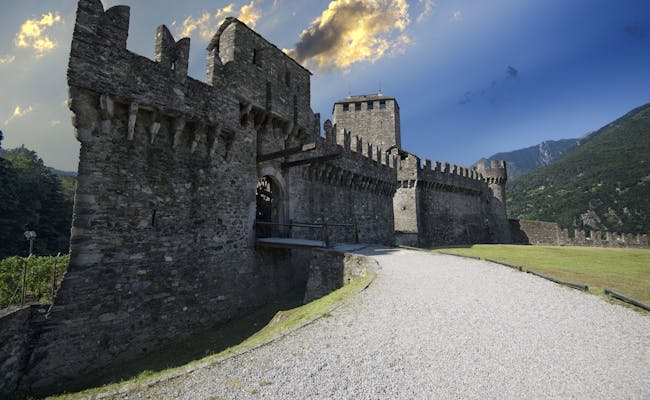
Get ready to explore the Italian part of Switzerland in all its glory. With so many activities to choose from, you won’t be bored today.
First, we recommend heading to one of the two river valleys: Maggia or Verzasca. Both are perfect for hiking, spending time by the river, or taking a refreshing dip. Don't forget to pack your picnic. In both valleys, there are countless spots to take a break. One of our favorite places is right under the famous stone bridge in Lavertezzo.
If you prefer calmer waters to the cold mountain streams, you should head to Lake Maggiore or Lake Lugano. Both lakes are stunning and offer more photo opportunities than you can imagine.
Other popular destinations in Ticino include the inspiring artsy town of Ascona near Locarno and the city of Lugano further south.
If you want to brush up on your knowledge of Swiss geography, visit Swissminiatur in Melide just outside Lugano. It’s a miniature version of Switzerland and shows an incredible attention to detail.
If you’re one of those adrenaline junkies, there’s the 007 Bungy at the end of the Verzasca Valley. You might have seen this 220-meter jump in the James Bond film GoldenEye. If you decide to take the plunge from the dam, don’t forget to share your photo with us. We’d love to see it… 🙂
As you might have noticed, this day is by no means long enough to get through everything on the list. Good thing there’s always tomorrow.
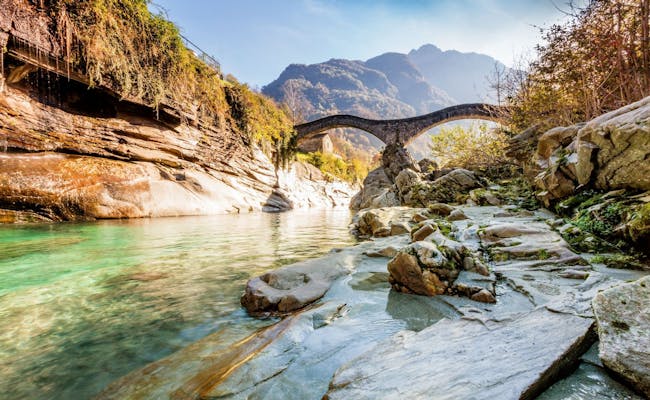

You’re probably going to laugh now. But the station your train to Domodossola leaves from is called Locarno FART. Unfortunate name, we know. It’s short for Ferrovie Autolinee Regionali Ticinesi and translates to “regional railway of Ticino”.
The ride to Domodossola lasts just under two hours. It might be the slowest train you’ve ever been on but chances are you won’t even notice time passing by.
The landscape is beyond stunning from start to finish. As you travel through the impressive Centovalli region – which stands for one hundred valleys – you’ll pass several charming villages with old stone houses, ride across tall viaducts and even catch a glimpse of a waterfall or two.
Enjoy the views because from Domodossola to Brig, you’ll be spending most of the time in a tunnel. That’s ok though because the ride from Brig to Zermatt is part of the Glacier Express – another scenic train ride.
Once you arrive in Zermatt, spend the rest of the day strolling through this little town and enjoy the sight of the mighty Matterhorn. Provided it’s not veiled in clouds.
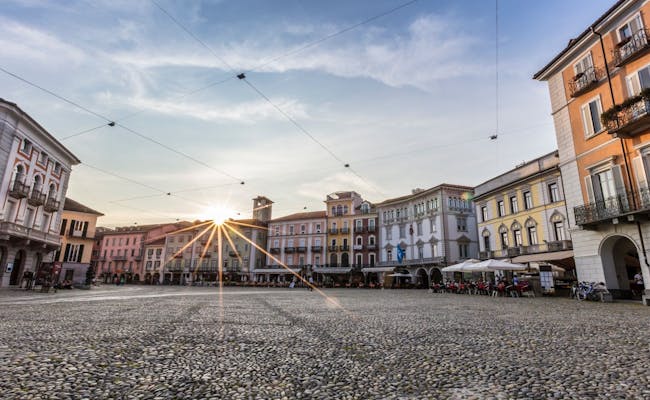

Zermatt is all about mountain scenery and nature. If you came to Switzerland for the spectacular mountain views, you’re going to love it here.
There are numerous hikes and walks of all difficulty levels that will take you to places you didn’t even know existed. For example, the popular Zermatt 5-Lakes Walk takes about 2.5 hours and passes five crystal-clear mountain lakes, providing stunning views of the Matterhorn along the way.
Another adventure that might leave you feeling a bit dizzy is crossing the world’s longest pedestrian suspension bridge in Randa. It stretches a full 494 m across the valley. The round trip to the bridge starts and ends in Randa, which is just a 15-minute train ride from Zermatt.
If you'd rather skip the hike and see the mountains the easy way, we recommend taking the train up to Gornergrat. After an incredibly steep train ride, you’ll find yourself at an altitude of 3,089 m above sea level, right in front of the Gorner Glacier and the Matterhorn. Don’t be surprised if you find yourself out of breath climbing the stairs to the viewpoint—that’s not just you, it’s the thin air.
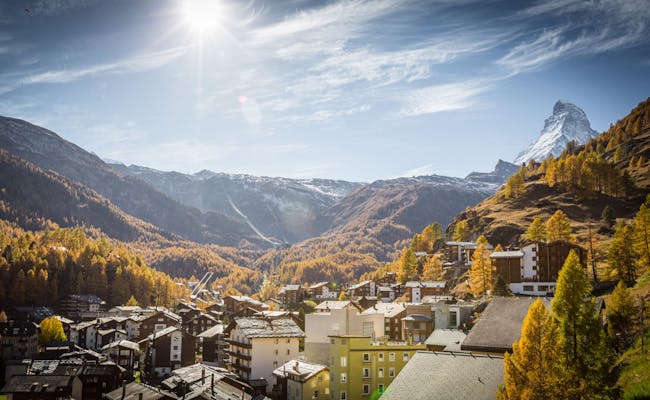
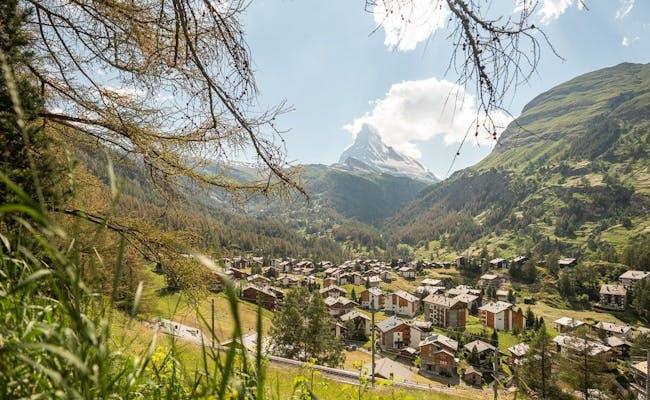
There’s certainly more than one day’s worth of things to do and see in Zermatt. Which means today is the perfect time to tick off anything you didn’t get round to yesterday.
Once you’re ready to leave the alpine air, catch the train back to Zurich. Or, if you’re flying out of Geneva or planning on visiting Switzerland’s second largest city, you can head in that direction instead.
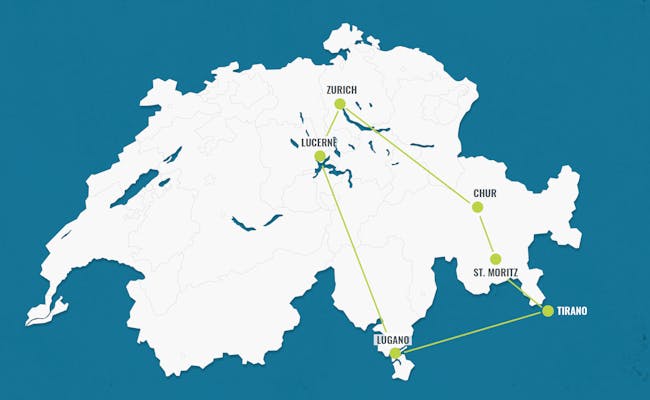
Highlights on this Route:
Explore Zurich on your own in the morning, rent a free bike with "Züri rollt," or join a city tour. After the tour, grab a takeaway lunch and enjoy it on the train to Chur.
To get a better view of Lake Zurich and Lake Walensee on the way to Chur, it's best to sit on the left side of the train.
Spend an hour or two wandering around Chur and gear up for the fresh mountain air awaiting you in St. Moritz. To head to St. Moritz, hop on the direct RhB train in Chur. Keep your camera ready because you'll be treated to panoramic views from start to finish. The Landwasser Viaduct and the winding Albula line are two highlights along this route.
Enjoy the rest of the day in St. Moritz. If you're feeling unusually sleepy this evening, it's likely due to the altitude of 1,822 m above sea level. Typically, it takes a day or two to acclimatize to the thinner air.
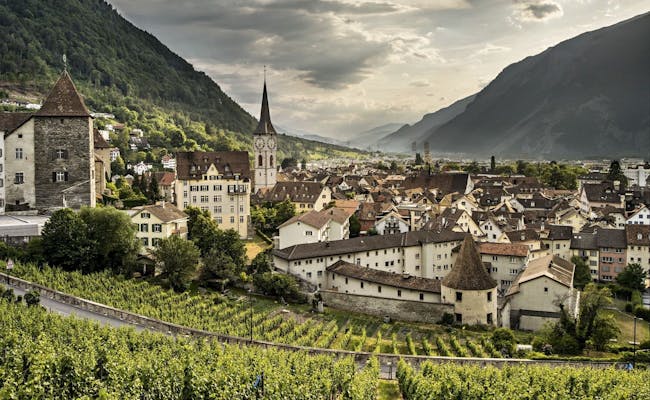

Today you’ll spend a few hours crossing the Alps from St. Moritz to Lugano. Your journey takes you up to the highest point of the Bernina Express line, past sparkling glaciers and crystal-clear mountain lakes, down into the southern part of Switzerland and over a spectacular viaduct before arriving in Italy.
And finally back to Switzerland…
The first stage of this train ride takes you to Ospizio Bernina, the highest point of today’s trip. This small station is not far from St. Moritz and sits at an elevation of 2,253 m above sea level. From here, you’ll descend into the valleys. Of course, that's just a figure of speech. On your way down to Italy, you’ll cross the circular viaduct in Brusio. Here, the train makes a full 360-degree turn to gain altitude.
At this point, you’ve already lost some elevation, and the outdoor temperature is much warmer than it was just a few hours ago. The last leg of the journey begins in Tirano, right at the Swiss-Italian border. From Tirano, the Bernina Express bus takes you through the stunning wine region of Valtellina.
Before you head back to Switzerland, you’ll pass by Lake Como, the place where George Clooney and many other celebrities have tied the knot.
After this long day, you can stretch your legs along the promenade of Lake Lugano. Enjoy the view, grab some ice cream, and stroll through Lugano.
You’ve earned it.

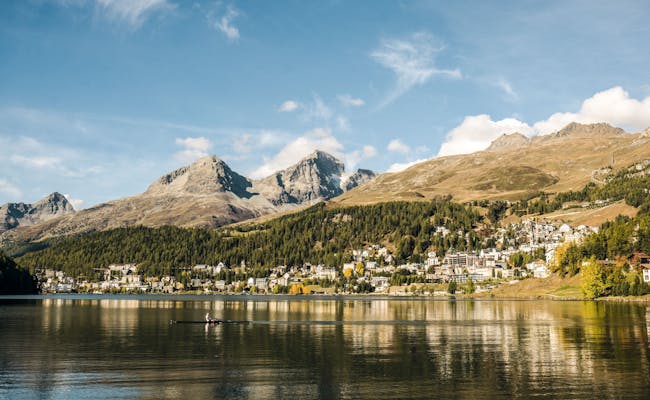
Since you're staying in the Canton of Ticino, you get to enjoy the fantastic Ticino Ticket. You'll receive it when you check into your accommodation. With this handy guest card, you can use public transportation across Ticino for free. Additionally, it offers plenty of discounts at various attractions and activities.
If you’re curious about what to do in the area, take another look at Day 2 of Itinerary No. 1. You'll find activities listed for about three days, which should keep you busy for a while.
Alternatively, you can leave Switzerland and hop across the border into Italy. Not far from Lugano is the picturesque region of Como, the place where George Clooney and other celebrities have tied the knot. If you’re wondering what Mr. Nespresso has seen in this part of the world, today’s your chance.
The two most beautiful spots in the region we recommend are the town of Como and the village of Menaggio. Both sit along the shores of Lake Como and will charm you. At the end of the day, you'll head back to Switzerland and spend the remaining time in Lugano.
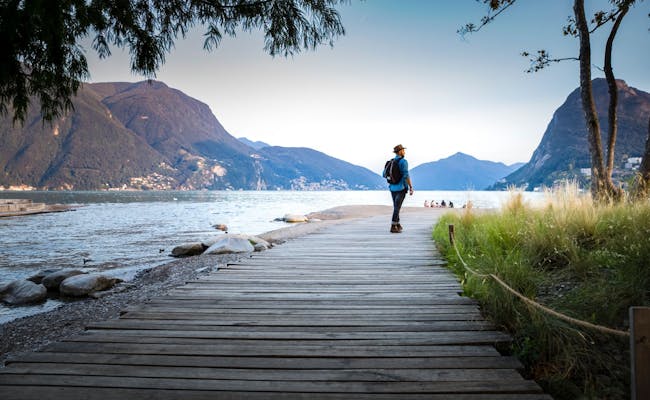
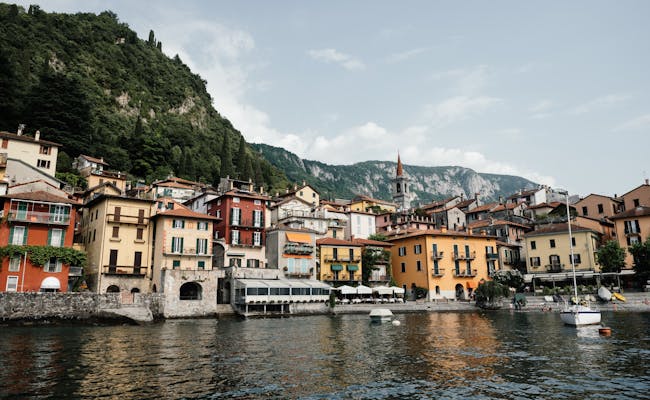
If you visit Switzerland between April and October, you're in luck. If you don't leave Ticino on a Monday, you have the chance to take the Gotthard Panorama Express back over the Alps.
On the first leg of this trip, a panoramic train takes you through the old Gotthard Tunnel to Flüelen. Before the Gotthard Base Tunnel opened in 2016, this was the only way to reach Ticino by train. Today, since the longest tunnel in the world opened, the old tunnel is only used for tourism purposes.
In Flüelen, you'll enjoy a three-hour boat ride on Lake Lucerne. You'll arrive in Lucerne at around 3:00 PM right next to the train station. This gives you plenty of time to explore this beautiful city and its surroundings. If you can't take the Gotthard Panorama Express to Lucerne, just hop on the regular train to Lucerne instead.
Luckily, you don't have to rush today and can enjoy Lucerne until the afternoon or even evening. You have enough time to check off everything you couldn't get to yesterday.
A popular day trip from Lucerne is a visit to Mount Rigi. To get there, either store your luggage at your accommodation in Lucerne or at the train station, and take the train to Arth Goldau. From there, the Rigi Railway—the first mountain railway in Europe—takes you to the Rigi Kulm summit in a 45-minute ride.
If Mount Rigi isn't shrouded in clouds, you'll be treated to a spectacular view of the Alps, Lake Lucerne, and other surrounding lakes. Just follow the signs to the viewpoint after you disembark at Rigi Kulm.
Once you've taken enough photos, you can either take a break at the restaurant, descend to Vitznau by train, or go hiking. With over 120 kilometers of hiking trails, you have plenty of choices.
When you arrive in Vitznau, a passenger boat to Lucerne will be waiting for you. Keep your camera ready, as the ride offers stunning scenery and even more breathtaking views.
Back in Lucerne, retrieve your luggage and head back to Zurich.
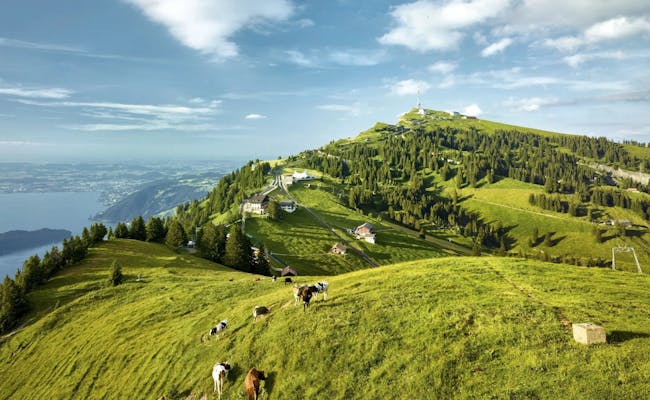
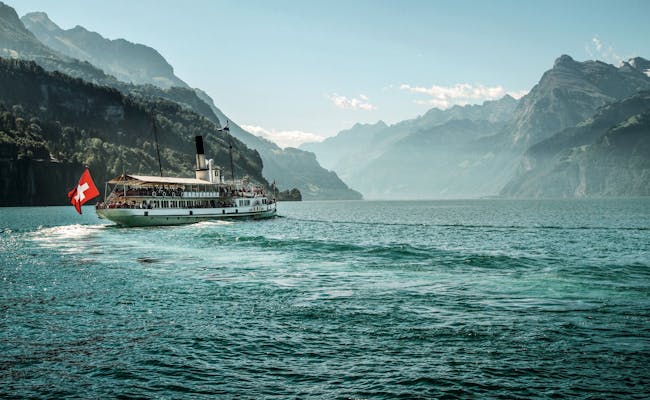
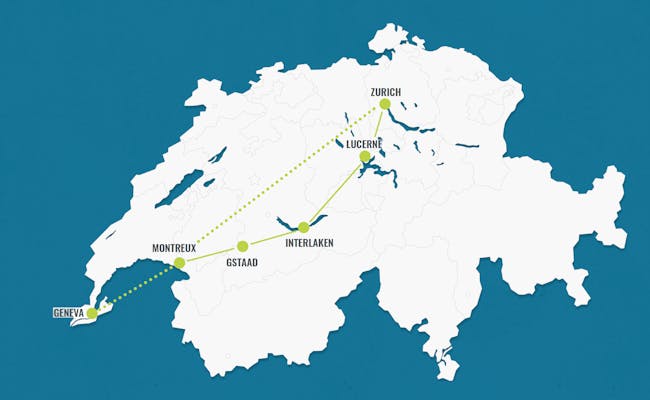
Highlights on this route:
Leave Zurich early in the morning, head to Lucerne, and spend a few hours exploring the city. Walk across the Chapel Bridge, wander through the old town, relax by the lake, or visit the Glacier Garden. Then continue your journey to Interlaken around noon.
The Golden Pass Line is a popular scenic route from Lucerne to Montreux, operated by several train companies. It connects the heart of Switzerland with the banks of Lake Geneva.
This panoramic route passes by eight lakes, travels through six different cantons, crosses three mountain passes, and connects two language regions. The leg from Lucerne to Interlaken, operated by the Zentralbahn, takes just under two hours.
Once you arrive in Interlaken, you'll spend the evening in this popular and very touristic town. There are countless activities to enjoy. If you want to fully experience this region, one night might not be enough. However, there should be ample time for a stroll along the Aare or a short trip to Harder Kulm.
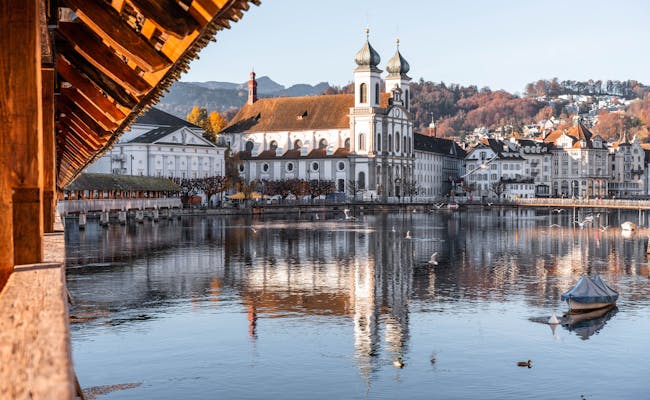

Today, you have more activities to choose from than you can imagine. It all depends on your budget, but in an adrenaline-fueled place like Interlaken, the sky's the limit.
If at all!
Skydiving, paragliding, canyoning, and jet boating are popular activities that will get your adrenaline pumping.
A more relaxing option is a cruise on the Thun or Brienz lakes. On both lakes, you'll be treated to breathtaking views, and you'll wish you never had to leave. If you'd like to make a stop during your cruise, you can disembark at Giessbach (Brienz Lake), at the St. Beatus Caves, or in Spiez (Thun Lake).
The Jungfrau region around Interlaken is also an excellent spot for hikers. The number of hiking trails is nearly endless. Regardless of your fitness level and ambitions, you'll find something that suits your taste here.
Of course, the famous Jungfraujoch—also known as the Top of Europe—is the number one destination everyone wants to see. With the Jungfrau Railway, you can take a ride up to the highest railway station in Europe and find yourself surrounded by impressive mountains and glaciers.
If you're looking for a more budget-friendly alternative to Jungfraujoch, we recommend visiting the Schilthorn, Schynige Platte, Grindelwald First, or the Männlichen instead. The journeys to these mountains and the views from the summit will not disappoint you.
Other attractions in and around Interlaken include: the Ballenberg Open-Air Museum, the chocolate workshop at Funky Chocolate Club, the two mountain lakes Blausee or Oeschinensee, and the Aare Gorge. And let's not forget the charming towns and villages like Brienz, Spiez, Thun, Lauterbrunnen, or Grindelwald.
We could go on forever here. But you’d probably just get annoyed that you aren't spending the whole week here.

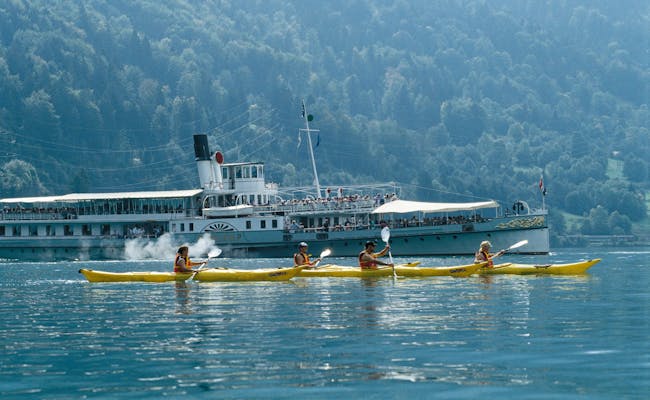
Today, you can look forward to another stunning landscape. As soon as you leave Interlaken heading towards Zweisimmen, you'll have Lake Thun on your right. For the best view of the lake, we recommend snagging a seat on the right side of the train.
After just over an hour of travel, you’ll need to change to another train in Zweisimmen. From there, the climb into the Bernese Oberland towards Gstaad begins. This region is a total dream for mountain lovers and encapsulates pretty much everything that makes Switzerland special. You'll find lakes, mountains, lush meadows with grazing cows, glaciers, plenty of hiking trails, wonderful landscapes, and charming little villages in abundance.
In Gstaad, you have several options for how to spend your afternoon. Since this area is a paradise for hikers, you’ll be spoiled for choice. One possible hike takes you to Lake Lauenensee, a mountain lake surrounded by moorland.
A great excursion that is easily doable from Gstaad is a visit to the impressive Glacier 3000. After a 35-minute bus ride to Col du Pillon, you'll arrive at the valley station of the cable car. Hop in the gondola and enjoy the ride. Once you reach the top, a breathtaking 360° view of the Alps awaits you.
On a clear day, you can see some of the most famous mountain giants of the Alps, like the Matterhorn, Mont Blanc, and the well-known trio of Eiger, Mönch, and Jungfrau. If you’re brave enough, you should dare to walk the Peak Walk to Scex Rouge. This is the world's first suspension bridge connecting two peaks. At Glacier 3000, there are also other activities available, such as the toboggan run or a hike across the glacier.
If you’re strolling through Gstaad in the evening, keep an eye out for celebrities. Famous faces often mingle here, much like in St. Moritz.

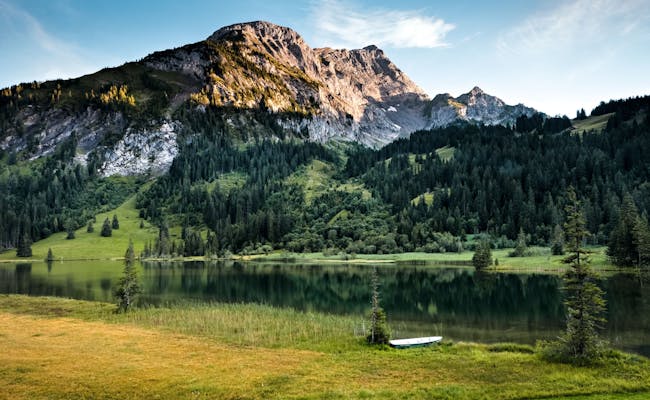
It's already time to say goodbye to this beautiful region. After breakfast, hop on the Golden Pass train and continue your scenic journey. Once you leave the Bernese Oberland and descend the hills, you'll arrive in the French-speaking part of Switzerland.
The Golden Pass Line ends in Montreux, where you'll spend your afternoon. Enjoy a few hours in this lovely area by Lake Geneva before heading to Bern.
Take a stroll along the promenade and check out the Freddie Mercury statue in front of the market hall. If you want to visit the famous Château de Chillon, you can follow the promenade to the castle or take the bus. Passenger boats also regularly operate between Montreux and Château de Chillon.
Alternatively, you can head in the other direction to the Lavaux vineyards. Just a short train ride west of Montreux, you'll find the famous Lavaux vineyards, a UNESCO World Heritage site. To enjoy the stunning views, get off at Cully or Epesses and follow the marked hiking trail through the vines.
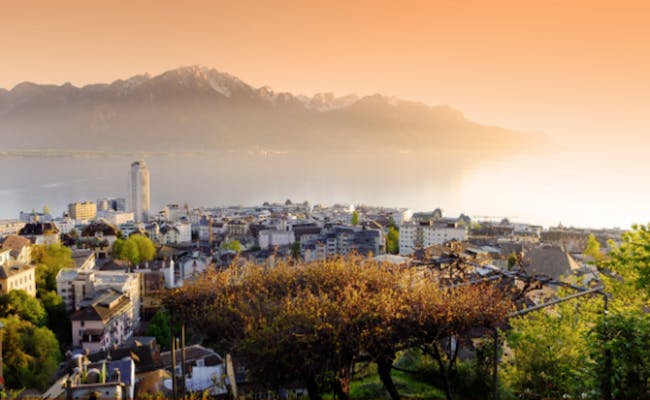

You probably didn’t have enough time to cover everything you wanted to yesterday. So spend however much time you need exploring Montreux and its surroundings today. If you’re out of ideas, start making your way to Zurich or Geneva. Whichever city it is you’re leaving Switzerland from. On the way to Zurich, you can stop over in Bern. If you travel towards Geneva, you could put in a stop in Lausanne.

Highlights on this route:
Leave Zurich early in the morning and take the train to Lucerne. Store your luggage either at the train station or in your accommodation and hop on the next train to Arth Goldau. From there, the Rigi Railway—the first mountain railway in Europe—will take you to Rigi Kulm station in just 45 minutes.
If Rigi isn't shrouded in clouds, you'll have a spectacular view of the Alps, Lake Lucerne, and other nearby lakes. Just follow the signs to the viewpoint after you disembark at Rigi Kulm.
Once you've taken enough photos, you can either relax at the restaurant, descend by train to Vitznau, or go for a hike. With over 120 kilometers of hiking trails, you'll have plenty of options.
Upon your arrival in Vitznau, the passenger boat to Lucerne awaits you. Keep your camera ready because the ride is incredibly scenic and offers even more breathtaking views.
Back in Lucerne, you can spend the rest of the evening exploring the town or find a cozy spot by the lake to unwind.
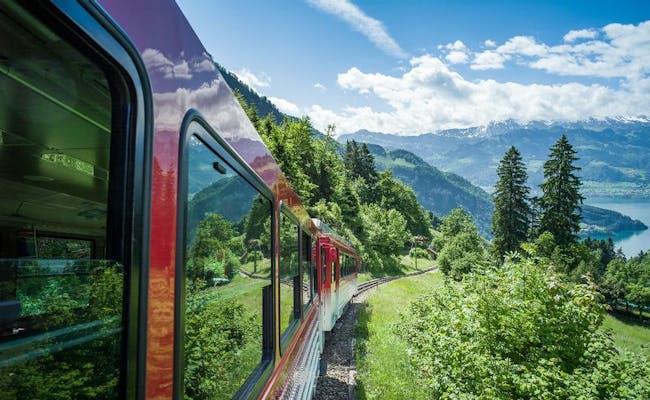
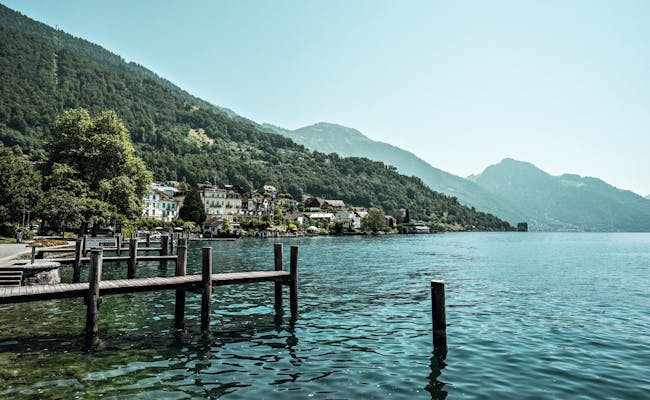
Lucerne has an incredible amount to offer. One of the most exciting excursions is the ride on the steepest cogwheel train in the world up to Pilatus, Lucerne’s local mountain. This train only operates in the summer from Alpnachstad, while the cable car from Kriens runs year-round to Pilatus.
Speaking of mountains: Titlis is another landmark in the region worth a visit. From Engelberg, you can reach the summit using two gondolas, one of which is the world’s first rotating aerial cableway, offering an impressive 360-degree view.
For an easy hike that includes a ride with a 152.8 m high rocket-like elevator, you can take a boat or bus to Kehrsiten-Bürgenstock.
Don’t forget about Stanserhorn, a mountain near Lucerne that has a modern double-decker cable car. It’s best to take a boat to Stansstad. Here, you’ll switch to the funicular for the first leg and ride the open-air gondola for the final stretch to Stanserhorn.
Another great way to spend the day around Lucerne is a trip on Lake Lucerne. There are several steam and passenger ships that will take you on a scenic outing.
As you can see, Lucerne has plenty to offer on a sunny day. But in reality, the weather isn't always that promising. In that case, here are a few cool indoor options for you.
For one, there’s Aeschbach’s Chocoworld in Root. The bus ride there takes about 30 minutes. Nothing brightens a rainy day quite like delicious chocolate, right?
In Hergiswil, not far from Lucerne, you’ll find what the Swiss lovingly call the "Glasi." The Hergiswil Glassworks takes you through the glass-making process, lets you watch the pros at work, and even gives you the chance to try your hand at glassblowing. When was the last time you made your own glass?
Another option for bad weather is the Swiss Museum of Transport in Lucerne. As the name suggests, this museum focuses on transportation. It covers everything from bicycles to astronautics.
Fortunately, you don’t need to leave Lucerne until around noon today. So, spend the morning doing what you couldn’t get to yesterday. Whatever you do, make sure not to spoil your appetite with a big lunch. You’ll need every inch of space in your stomach for the feast that awaits you.
When you’re ready to move on, take the train to Trubschachen. This train splits along the way, and only the front part goes through the picturesque Entlebuch to the Kambly Factory. When you’re at the platform in Lucerne, check the display to ensure you’re boarding the correct train section.
You don’t need a ticket for the Kambly factory store right next to the train station in Trubschachen. Admission is free. You can spend as much time as you like here and try up to 100 varieties of delicious biscuits.
Unfortunately, you can’t directly tour the factory or watch the production of this traditional Swiss treat. However, there’s a cinema in the store where you can learn more about the Kambly family business.
If you’re either about to explode from all the goodies or simply can’t eat another sweet, you can continue on to Bern. To help digest your Kambly overdose, take a stroll through the capital of Switzerland. For an impressive view over Bern, we recommend heading up to the Rose Garden.
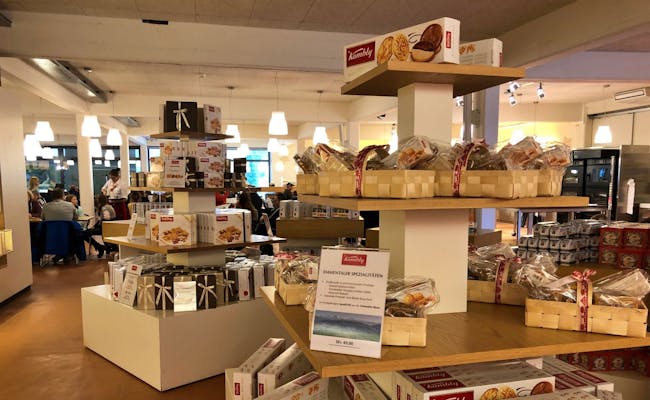
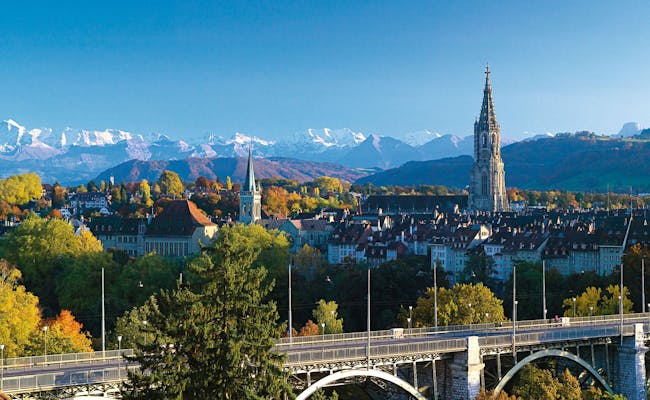
Today you're going on a day trip to one of Switzerland's most popular destinations. Interlaken is almost always on the list of places to visit for anyone traveling to Switzerland. And while there are plenty of other spots with breathtaking views and perfect hiking opportunities, you won't find many places as geared towards tourists as Interlaken.
A detailed list of activities in and around Interlaken can be found on Day 2 of Itinerary No. 3, where we've put together a list of things to do for about three days. That should keep you busy for a while.
If you leave Bern early in the morning, you'll have enough time to catch the passenger ship to Interlaken from Thun. This boat ride takes just over two hours and will likely leave you speechless.
You’ll pass charming villages and tall mountains as you cross Lake Thun before arriving in Interlaken. This is probably one of the most beautiful boat trips in Switzerland. And even if the weather isn't perfect, it's a mystical experience that's worth getting up for.
Additionally, the trip is completely covered with an Interrail, Eurail, or Swiss Travel Pass. Don’t miss out on this opportunity…
Today, you can choose from a variety of activities. Join a city tour or explore Bern on your own. Stroll through the old town, visit the Bear Park, check out the Federal Palace, and walk back to the Rose Garden to take in the view.
You could also visit the Gurten – Bern's local mountain – watch the animals at Dählhölzli Zoo, or explore the Botanical Garden. Take the lift at the train station and enjoy the view from the Grosser Schanze, or go for a swim in the Aare or at Weyermannshaus.
Oh, the choices...
At the end of the day, you'll take the train back to Zurich and spend the rest of the day exploring Switzerland's largest city.
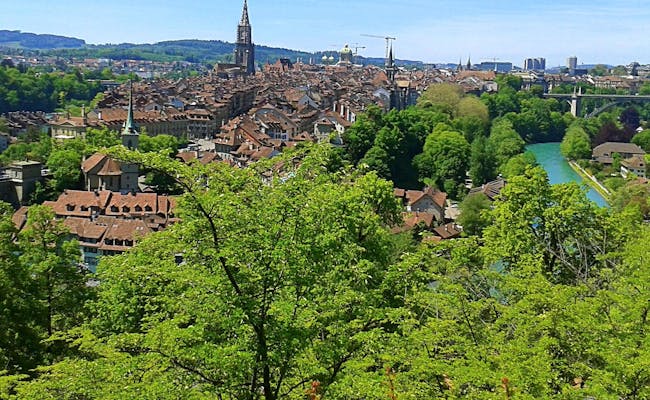
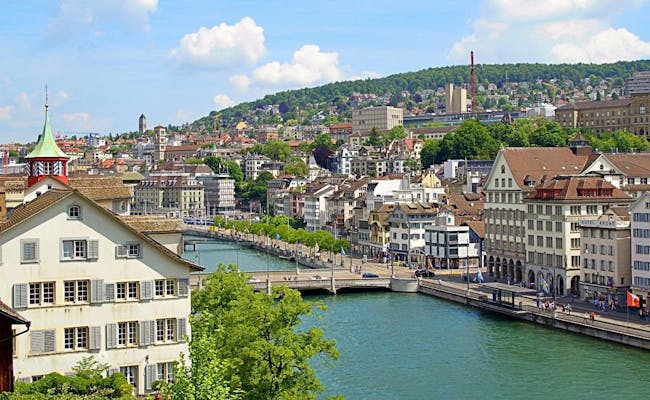
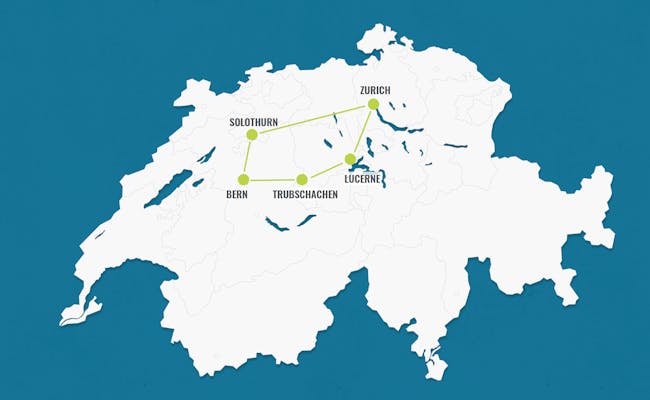
Highlights on this itinerary:
Leave Zurich first thing in the morning and head to Solothurn, commonly known as Switzerland’s most beautiful baroque city. With its impressive baroque cathedral and the many hidden and pretty alleyways, the city has earned this title with no doubt.
After a few hours of exploring Solothurn, hop on the passenger ship to Biel. How long you stay on it really depends on your preferences. You can go all the way to Biel – which takes around three hours – or get off anywhere along the way and catch the train back to Solothurn.
One of the highlights on this tour will be Switzerland’s largest stork station in Altreu, which you’ll pass about 45 minutes into the journey. In 1950, when storks were nearly extinct in Switzerland, Max Bloesch started his reintroduction project to save our storks. Thanks to him, around 40 breeding pairs can be seen soaring through the air, strutting across the fields and clattering on the rooftops around Altreu these days.
Only in spring and summer, though. They travel to warmer territories in autumn until winter is over.
If you continue your journey onward to Biel, the views of the Jura mountains and the Swiss Central Plateau will accompany you all the way. After passing through a watergate, you’ll arrive at the port in Biel, which is only a short walk from the train station.
From there, heading back to Solothurn will take 15 minutes by train.
Although Solothurn is by no means a big city, there’s still plenty to see and do in the area. One activity we particularly recommend is going on a hike in the Jura mountains. This high plateau is a wonderful area to visit all year round.
One option to reach the top with its countless walking trails is by cable car from Oberdorf to Weissenstein. Feel free to walk as long and as far as you like before hiking back down or catching the cable car to Oberdorf.
A very popular hike is the round trip from Solothurn via Balmberg and Weissenstein. Catch the Postauto in Solothurn, get off at Balmberg, walk along the crest to Weissenstein and head back down to Oberdorf by cable car. From Oberdorf, the train will take you back to Solothurn.
This is an easy walk and takes you into the Jura without too much effort. During your hike, you’ll also enjoy the view over the Alps, including Eiger, Mönch and Jungfrau.
Another place you can visit is Verena Gorge. You can walk along the creek through the forest in the gorge until you reach the little hermitage at the end. The walk takes roughly 45 minutes return and is super peaceful.
In the evening, treat yourself to a few scoops of ice cream at Vitaminstation – one of the ice cream places ever – and have it while sitting on the stone wall along the River Aare.
You’ll fit right in with the locals in doing so.
Seraina’s Tip: My two absolute favourite places for food in Solothurn are Pittaria and Vitaminstation. Anyone that likes a good falafel or hummus is going to love Pittaria. And Vitaminstation makes some of the best ice cream I’ve ever tasted in Switzerland.
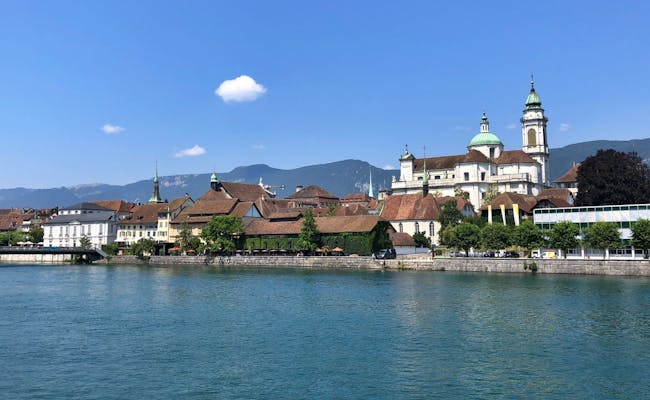

Leave Solothurn after breakfast and head to Bern, the capital of Switzerland. In this beautiful city, which is recognized by UNESCO, you’ll have plenty of activities to choose from.
Join a city tour or explore Bern on your own. Stroll through the old town, visit the Bear Park, check out the Federal Palace, and take a walk back to the Rose Garden to enjoy the view.
You can also visit the Gurten, Bern’s local mountain, watch animals at the Dählhölzli Zoo, or check out the Botanical Garden. Take the lift from the train station and enjoy the view from the Grosse Schanze, or go swimming in the Aare or at the Weyermannshaus.
You’re sure to find enough things to keep you occupied for the day. In the evening, we recommend heading up to the Rose Garden, where you can enjoy an impressive view over the city at night.
Bern is close to a multitude of varied excursion destinations. For example, there are Thun and Interlaken, two wonderful spots with spectacular lake and mountain views. If you want to head that way, check out Day 4 of Route No. 4.
If you’re interested in mountain lakes, you have two great options from Bern. The Oeschinensee and the Blausee are easily accessible from Bern and definitely worth a trip. The crystal-clear waters of both lakes will captivate you.
Just half an hour west of Bern is the medieval city of Fribourg. If you decide to go there, follow the signs for the city tour that will lead you through the impressive old town. The signs will guide you through steep alleys, over old wooden bridges, down to the river Saane, and past the city’s funicular railway. For an even better view of your surroundings, climb the 365 steps to the tower of the cathedral. The river Saane at the foot of the city is a great spot to stretch your legs and grab a snack.
You could even go further and visit Gruyères and Broc to taste some typical Swiss cheese and chocolate. Whatever you do today, return to Bern for your last night whenever you’re ready.
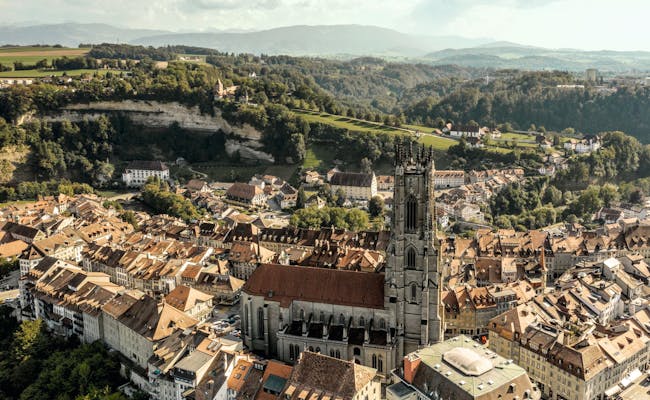

It’s crucial you keep your breakfast to a minimum today. Because as soon as you’ve swallowed your last bite, it’s time to catch the train to Truebschachen. This is the place where the iconic Kambly biscuits come from.
The Kambly factory store right next to Trubschachen station is free to visit. In here, you can spend as much time as you like tasting up to 100 types of delicious biscuits. Second breakfast anyone?
Unfortunately, you can’t visit the factory and watch the production of this iconic Swiss biscuit. However, they do have a cinema at the shop where they give you some more insight into this traditional family business.
After reaching the point of explosion, or maybe two bites before, move on to Lucerne.
To digest your Kambly overdose, walk across the Kapellbrücke, take a stroll through the old town, hang out by the lake or visit the Glacier Garden with its famous Lion Monument. Toward the end of the day, catch the train back to Zurich and spend the rest of the day exploring Switzerland’s largest city.
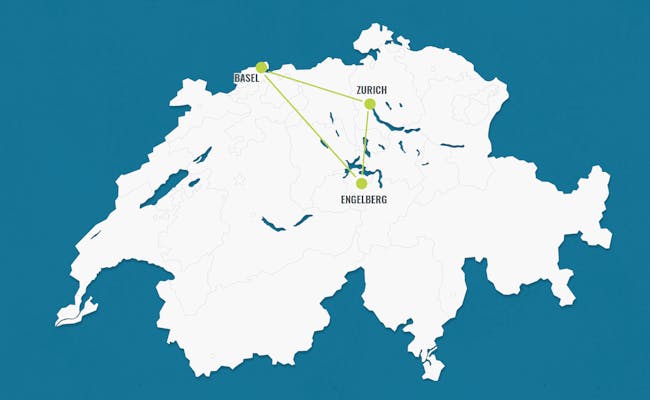
Highlights on this route:
Spend the morning exploring Zurich on your own, rent a free bike with “Züri rollt” or join a guided city tour. After the tour, grab a take-away lunch and take the train to Engelberg.
This diverse mountain village is located about 25 km south of Lake Lucerne at an elevation of 1013 m above sea level. Towering above all other peaks around Engelberg is the impressive Titlis at 3239 m above sea level.
Since you’ll be arriving in Engelberg in the afternoon, there won’t be enough time for an ascent right away. Let’s save that for tomorrow so you don’t feel rushed.
Instead, you can explore the center of Engelberg this afternoon. More specifically, the Benedictine monastery. This ancient monastery was founded in 1120 and is still inhabited by around 20 monks. You can either visit it on your own or join a guided tour.
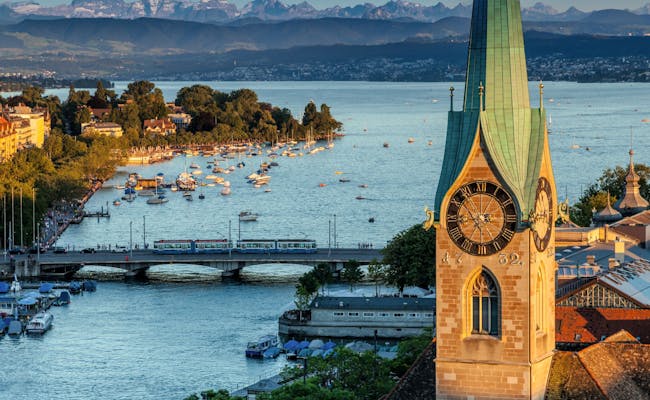

Like many places in the Swiss Alps, Engelberg focuses on outdoor activities. The most popular destination in this area is undoubtedly the Titlis. From Engelberg, you can reach the summit using two gondolas. One of them is the Rotair, the world’s first rotating cable car that spins 360°. At the summit, you're greeted with breathtaking panoramic views. Additionally, there’s a spectacular glacier cave and the thrilling Titlis Cliff Walk by Tissot.
The hiking options in Engelberg are virtually endless, catering to every taste. A highly recommended hike is the "Kitzelpfad" in Brunni. Here, you take off your shoes and walk over various types of terrain. While your feet are pampered by nature, you can also enjoy a perfect view of the Titlis.
And what would a proper hike be without one or two mountain lakes...?
A more challenging hike called the Four Lakes Trail takes you past - as you might have guessed - four mountain lakes. Since this hike takes almost five hours, we only recommend it if you feel fit enough.
If you're looking to spend a less strenuous day, you can choose the wheelchair-accessible path around Engelberg. This two-hour hike starts at the monastery in the center of Engelberg and leads to the picturesque Aa river and back. Even though you won’t reach the summits on this hike, you’ll still enjoy a lovely view of the mountains.
In the winter, Engelberg transforms into a true paradise for snow lovers. Whether you enjoy skiing, snowboarding, snowshoeing, hiking, cross-country skiing, ice skating, or sledding, you’ll find plenty to satisfy your expectations. Engelberg is particularly popular among freeriders.


If you wanted to get something done in Engelberg yesterday but didn’t have time, you can catch up on that this morning. After that, head to Lucerne when you’re ready. The trip from Engelberg to Lucerne takes less than an hour and is very straightforward.
Once you arrive, you can store your luggage at the train station and spend a few hours exploring this charming city. Walk across the Chapel Bridge, wander through the old town, relax by the lake, or visit the Glacier Garden with its famous Lion Monument.
You have the whole afternoon ahead of you, so take your time. For more ideas on what to do in Lucerne, check Day 2 of Itinerary No. 4.
The train ride from Lucerne to Basel only takes an hour. Spend the rest of the day by the Rhine or stroll through Basel's old town.
Basel is a vibrant city right on the German-French border. Here you’ll find a wealth of guided and self-guided city tours. Some of them focus on specific themes, such as "Basel by Night" or "Prison Breaks". Don’t miss the chance to gain deeper insight into the cultural richness of this city.
You can, of course, also explore on your own. Stop by the Pfalz - the perfect viewpoint for photos - walk along the Rhine, and watch large cargo ships come in and out of the harbor. Pass by the Basel Minster or visit one of the many museums. Basel has a very high density of museums. Whether you're interested in culture, art, or history, you’re sure to find something that suits your taste.
If you’re visiting in the summer, you might even go for a swim in the Rhine. That’s exactly what the locals do. Before they jump into the water and let the current carry them downstream, they pack their clothes into something called a "Wickelfisch". This dry bag is shaped like a fish and is a trademark of Basel.
If you’ve seen enough of the city by the afternoon, you can easily hop across the border to visit Weil am Rhein in Germany or St. Louis in France.
Theoretically, you can even visit three countries in one day. That’s quite doable in Basel and an experience you might not have every day. Especially if you come from a country where you have to board a plane to cross the next border in a reasonable time...
If there’s something you didn’t manage to do in Basel yesterday, today is your chance. Whenever you’re ready to leave, head back to Zurich and spend the rest of the day exploring the largest city in Switzerland.
If time allows, you can end this itinerary with a visit to the Lindt chocolate factory. Just a short distance from Zurich, in Kilchberg, you’ll find the brand new Lindt Visitor Center, which opened its doors to the public in September 2020. If you’ve never tried a roasted cocoa bean, eaten as many Lindor truffles as possible, or spent a bit of time with the tallest chocolate fountain in the world, this is your chance.
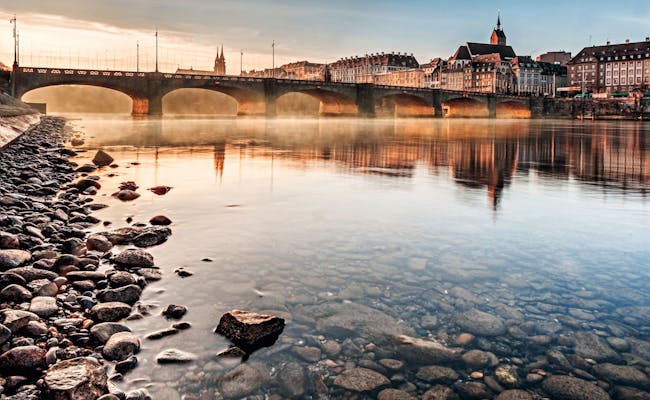

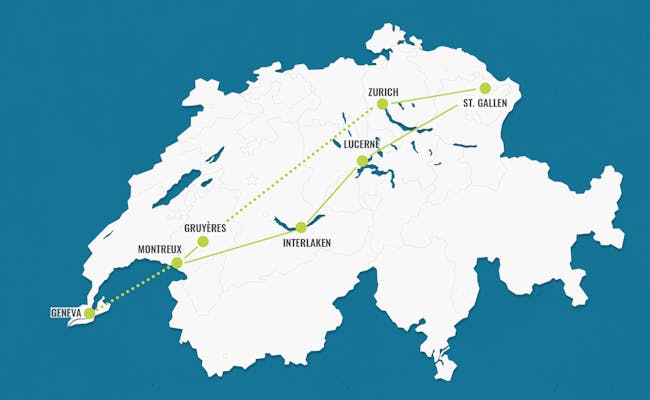
Highlights on this route:
Explore Zurich on your own in the morning, rent a free bike with "Züri rollt", or join a city tour. After your tour, grab a take-away lunch and catch a train to St. Gallen.
Spend the afternoon discovering the old town of St. Gallen. This city has a lot to offer with its UNESCO-protected Abbey District, its impressive cathedral, and the stunning Abbey Library.
You shouldn't miss the recreational area “Drei Weieren.” You can reach it either by the Mühleggbahn or on foot via one of the many stairways. Alternatively, you can visit the Peter & Paul Wildlife Park or quench your cultural thirst in one of the many museums.
The absolute best place to relax is at the “Drei Weieren.” Here, you can go swimming or take a walk through the woods. Plus, you’ll get a fantastic view over the entire city, Lake Constance, and even as far as Germany.
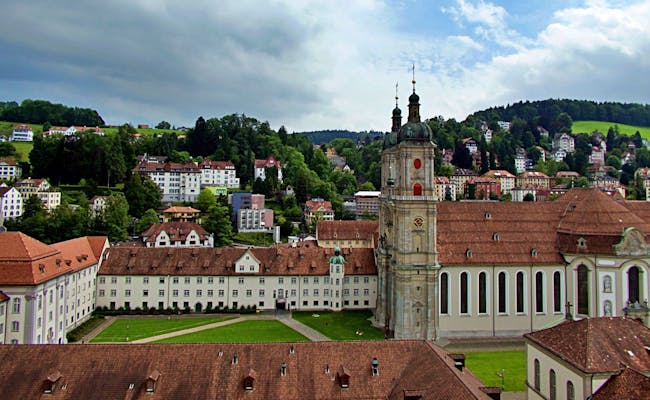

Fortunately, you don't have to leave St. Gallen until midday today. So spend the morning doing what you didn’t manage to get done yesterday. Grab some lunch to go around noon and take the Voralpen Express to Luzern.
Of all the scenic train rides in Switzerland, this one is significantly less touristy. There are no large panoramic windows or friendly voices telling you which viaduct you’re crossing.
But that doesn’t make the journey any less worthwhile.
We recommend breaking your trip halfway and getting off in Rapperswil. This city is a hidden gem at the lower end of Lake Zurich. Visit the castle, spend some time with the deer in the castle garden, go for a swim in Lake Zurich, and stroll along the charming lakeside promenade.
A fantastic spot to relax is the meadow behind the OST, the University of Applied Sciences in Rapperswil. You can't miss it if you head towards the lake from the train station.
If you feel like going for a gentle walk, follow the wooden path and the connecting bridge over the lake to Pfäffikon. This lets you walk three kilometers of the Camino de Santiago, a pilgrimage route that leads from various places in Europe to Santiago de Compostela in Spain.
When you're ready to continue, hop on the next train to Luzern and spend the afternoon exploring the city. Walk across the Chapel Bridge, wander through the old town, relax by the lake, or visit the Glacier Garden with the famous Lion Monument.
You can find a detailed list of activities in Luzern on Day 2 of Route No. 4.
On today’s train journey, you’re in for some of the best views Switzerland has to offer.
The Golden Pass line is a popular scenic route from Luzern to Montreux, operated by several train companies. It connects the heart of Switzerland with the shores of Lake Geneva.
The scenic route passes by eight lakes, travels through six different cantons, crosses three mountain passes, and connects two language regions. Your first leg from Luzern to Interlaken is serviced by the Zentralbahn and takes just under two hours. Since you have a relatively long journey ahead, we recommend staying in Interlaken for no more than one or two hours.
The second part of the journey first leads you past Lake Thun to Spiez, and finally to Zweisimmen where you'll change to another train. Here, the ascent through the Bernese Oberland towards Gstaad begins. This area is a true paradise for mountain lovers and encompasses pretty much everything that represents Switzerland—lakes, mountains, lush meadows with grazing cows, glaciers, plenty of hiking trails, stunning landscapes, and charming little villages in abundance.
Even if you don’t have time to get off along the way, the ride through this picturesque region is something you’ll probably not forget anytime soon.
After leaving the Bernese Oberland and descending the hills, you’ll arrive in the French-speaking part of Switzerland. Spend the rest of the day exploring Montreux and its surroundings.
Bienvenue...
The Golden Pass line ends in Montreux. Depending on when you arrive, you might have an hour or two to explore the city. Head to the promenade, check out the Freddie Mercury statue in front of the market hall, and stroll through the city. There's no rush; you'll be spending the next two nights here, giving you plenty of time to discover Montreux and its surroundings.


Today is all about cheese and chocolate, as Switzerland is famous for both. So, hop on the train to Gruyères and get ready for a feast in a medieval town.
The Gruyère cheese factory is just behind the train station. You can watch how traditional Gruyère cheese is made, and of course, there are samples to try. Once you're done tasting, you can either take the bus or follow the walking path to the center of Gruyères. This stroll takes about 20 minutes.
The main attraction in Gruyères is probably the castle, which is open to the public and costs 12 CHF to enter. But the charming cobblestone streets and numerous souvenir shops might entice you to stick around longer than you planned.
After exploring Gruyères and maybe picking up a souvenir or two, you can head to Broc and visit La Maison Cailler. At their visitor center, you'll learn everything you need to know about the oldest chocolate brand in Switzerland. At the end of the tour, there's a buffet where you can taste a ton of chocolate.
On the train ride back to Montreux, you can try to digest your cheese and chocolate feast. Spend the rest of the day in Montreux. If you're interested in castles, don’t miss a visit to the famous Château de Chillon. You can reach it by walking along the promenade, taking a bus, or hopping on one of the regularly scheduled passenger boats.
Even if you're not keen on touring the castle, we recommend making a stop to spend some time by the lake. It’s a great spot to relax and take lots of beautiful photos.
Only a short train ride west of Montreux, you’ll find the famous Lavaux vineyards, a UNESCO World Heritage site. Taking a stroll through the vineyards with the perfect view of Lake Geneva is almost a must in this area. So venture right out after breakfast.
To fully experience the gorgeous views, get off in Cully or Epesses and follow the signposted footpath through the vineyards. Once you’re ready to continue your journey, either head back to Zurich or hop on the train to Geneva. Whichever city it is you’re leaving Switzerland from.
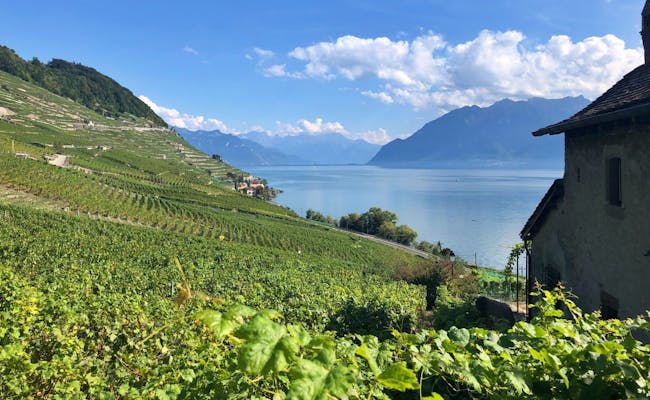
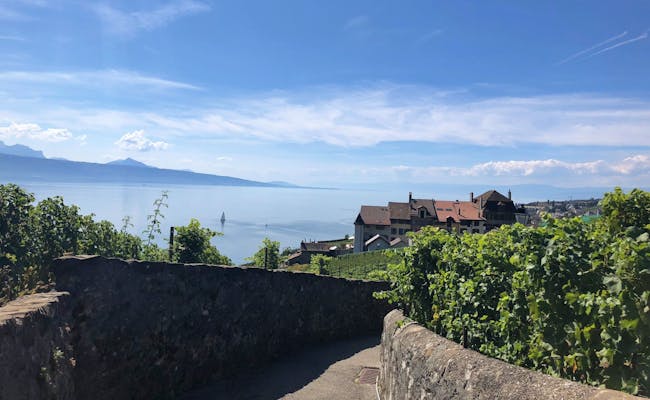

Highlights on this route:
Spend the morning exploring Zurich on your own, rent a free bike with “Züri rollt” or join a city tour. After the tour, grab a take-away lunch and take the train to St. Gallen.
Explore the old town of St. Gallen in the afternoon. With its UNESCO-protected Abbey District, its impressive cathedral, and the remarkable Abbey Library, this city has a lot to offer.
Don't miss the recreational area “Drei Weieren.” You can reach it either by taking the Mühleggbahn or by walking up one of the many staircases. Alternatively, you could visit the Peter & Paul Wildlife Park or quench your cultural thirst in one of the many museums.
The best place to relax is definitely in the “Drei Weieren.” Here you can go swimming or take a walk through the forest. Plus, you have a fantastic view over the entire city, Lake Constance, and even as far as Germany.
The next two days are all yours to explore the mountain range known as Alpstein. Leave any luggage you don’t need in St. Gallen and get ready for wonderful hikes.
There are endless hiking opportunities in this mountain range. Whether you want to visit the famous Äscher restaurant or go for a swim in the charming Seealpsee, you’re sure to find something amazing here.
Since you have two days, let’s introduce one of our favorite hikes in Alpstein. It starts in Brülisau, passes by two mountain lakes, leads you to fresh milk and cheese, possibly includes a night in a barn above the cows, and definitely guarantees some tired legs.
First, make your way to Brülisau in the canton of Appenzell Innerrhoden. From there, you’ll begin your hike to the Ruhesitz restaurant, which is about halfway up to the Hoher Kasten mountain. From Ruhesitz, follow the signs leading you to the Sämtisersee. You might just be ready for a break here. Spend as much time as you’d like at or in this beautiful mountain lake.
From Sämtisersee, continue hiking until you reach Bollenwees at Fälensee. If you’re looking for a bit more comfort, you can spend the night at this mountain inn. Bollenwees offers private rooms or dormitories with showers, along with a restaurant. The view of the lake is unparalleled. After such a long hiking day, you’ll likely be glad to just stretch your legs and enjoy the breathtaking scenery.
But if you’re in the mood for a little adventure, you should hike a bit further. If you follow the Fälensee all the way to the end, you’ll come across Fälenalp. On this small alp, a farming family spends the summer with their cows, goats, and pigs. The family offers beds in a large dormitory in the barn above the cows and is happy to cook a delicious dinner for you.
If you decide to spend the night at Bollenwees, we still recommend taking a walk to Fälenalp to see this magical place and try some fresh goat cheese. Either today, after checking in at Bollenwees, or tomorrow, before heading back to St. Gallen.

Wherever you spent last night, we hope you slept well in this fresh mountain air. How you plan out your day today is totally up to you. You haven’t exhausted your hiking options by far, so keep going for as long as you please.
One option is to climb to Bogartenmannli and terminate your hike in Wasserauen after passing Seealpsee. This should put you on the train to St. Gallen some time in the afternoon. Or you can just walk back to Brülisau via Sämtisersee and Brüeltobel. The world is your oyster here.
On your way back to St. Gallen, you might like a quick stopover in Appenzell, the charming capital of the Canton of Appenzell Innerrhoden. In case you’re feeling brave, visit the little cheese store at Hauptgasse 13. But be warned, those smelly cheese fumes will knock your socks off the second you enter the store.
There’s no way your feet will be able to compete with that odour. Not even after two full days of being trapped inside your trekking boots... 🙂
Oh, and don’t miss out on a piece of Appenzeller Biber, an iconic local sweet treat made of gingerbread and a honey almond filling. And before you ask: Nope. This Biber doesn’t have any famous Canadian relatives...
Also, if you’re a beer-lover, make sure to stop by the Locher brewery. They brew the popular Quöllfrisch beer that is consumed all across Switzerland. In the evening, head back to St. Gallen and enjoy sleeping like a baby tonight. Spending a day or two in the mountains has a tendency to leave you peacefully exhausted.
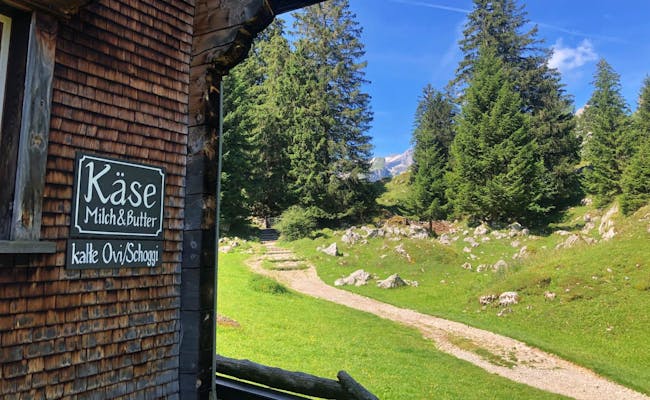
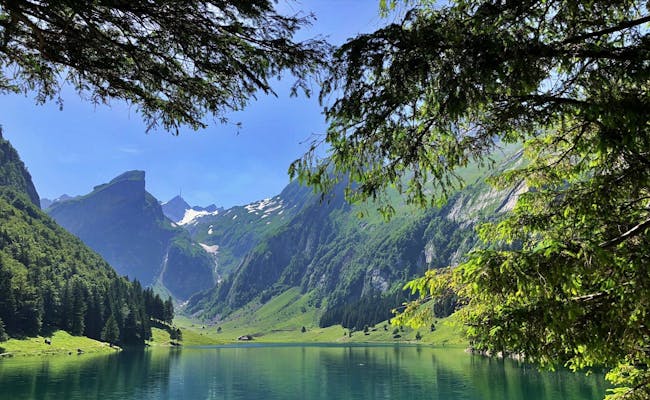
Today, it's time to take it a bit easier. After two intense and possibly exhausting days in Alpstein, you pack your bags and head to Kreuzlingen by Lake Constance. Lake Constance is 63 kilometers long and up to 14 kilometers wide, sharing its shores with Germany, Austria, and Switzerland. In this trinational area, there are plenty of sights and activities for you to discover.
For example, there's the picturesque city of Konstanz in Germany, which you can easily reach on foot from Kreuzlingen. Most Swiss people go there for affordable shopping. But Konstanz has more to offer than just budget stores.
With its charming old town, a variety of cafés, restaurants, ice cream parlors, and serene spots by the lake, Konstanz attracts many visitors during the warmer months. If you're interested in fish and other underwater creatures, Sea Life is always a great option when the weather isn’t cooperating.
Of course, you don’t have to leave Switzerland to fully enjoy Lake Constance. Visit one of the many beaches, go swimming, take a passenger boat ride, rent a stand-up paddleboard, grab a bike and follow the paths, or take a stroll along the lakefront.
The canton of Thurgau, which encompasses most of the Swiss part of Lake Constance, is famous for its apple trees. One of the walks we recommend in this area is the Altnauer Apple Trail. It's particularly idyllic when the trees bloom in April and May or during the harvest season in autumn. The path is divided into three separate trails, each marked with informational signs on various topics. If you combine all three trails, you'll learn everything there is to know about apples. Along the way, there are also plenty of opportunities to buy and sample a variety of apple products.
Other interesting places around Lake Constance include the towns of Romanshorn, Rorschach, and of course Kreuzlingen, where you'll be staying.
In the morning, you can spend some time at or in Lake Constance. The train ride to Zurich takes just over an hour. So you can enjoy the whole day at Lake Constance if you like.
However, if you’re ready to move on after lunch, you can take the train to Neuhausen to visit the largest waterfalls in Europe. The mighty Rhine Falls draws visitors from all over the world and is an impressive natural spectacle. Take your time soaking in the beauty of the Rhine Falls.
Once you've seen enough, you’ll head back to Zurich and spend the rest of the evening exploring Switzerland’s largest city.
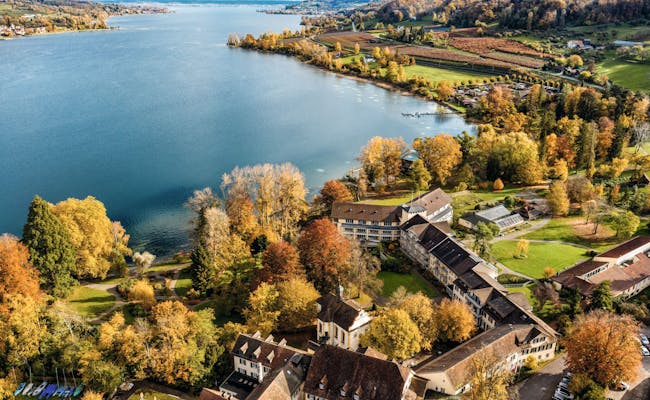


Highlights on this route:
Explore Zürich on your own in the morning, rent a free bike with “Züri rollt”, or join a city tour. After the tour, grab a take-away lunch and catch a train to Chur.
Spend an hour or two wandering through Chur - the capital of the canton of Graubünden - and get ready for the fresh alpine air waiting for you in Davos. Before you head on to Davos, make sure to visit two of the most beautiful Swiss mountain lakes. Lake Cauma and Lake Cresta are not far from Chur. These picturesque lakes are very popular with both locals and visitors.
Another amazing spot in the area is Ruinaulta, the stunning Rhine Gorge. This UNESCO World Heritage site is rightly nicknamed the “Swiss Grand Canyon.” There's a hike that connects the Rhine Gorge with Lake Cauma and Lake Cresta. This easy 2.5-hour hike starts at the post bus stop Flims Waldhaus. Depending on how much time you spent in Zürich and Chur today, you might be able to complete the entire hike. If not, just pick one or two destinations before taking the train to Davos.
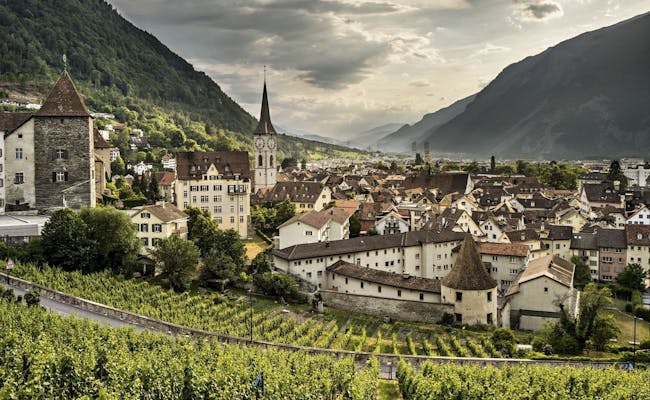

Davos is located at 1,560 meters above sea level and is the highest city in the Swiss Alps. It's also a popular destination for hikers, skiers, bikers, and outdoor enthusiasts in general. In summer, three cable cars take you up into the mountains, where an extensive network of hiking trails awaits you. Together, these trails span about 700 kilometers. Enough to keep you busy for a day.
If hiking isn't your thing, there are plenty of other ways to spend your time in Davos. You could go mountain biking, paragliding, or take a stroll around Lake Davos. If you're visiting in winter, you're in for a treat. In Davos, you can ski, snowshoe, cross-country ski, or just take a walk in the snow.
You have until late afternoon to enjoy Davos before heading off to Scuol. The train ride takes just over an hour, and you'll need to change at Landquart. You'll notice that Scuol, while also in the canton of Graubünden, feels quite different from Davos. Fortunately, you have two more days to explore the stunning Engadin region.
The Engadin is a beautiful place, especially in autumn when the leaves turn yellow, orange, and red. But it's a fantastic destination year-round.
For time reasons, it's a good idea to head straight to the national park in the morning and explore Scuol later. If you ask nicely, you might be able to leave your luggage at your accommodation in Scuol until you return from the mountains tomorrow evening.
The rules for visiting the only Swiss national park are quite strict. You can't leave the marked paths, take any plants, or make fires, etc. When you arrive at the park entrance, make sure to read the signs or stop by the visitor center in Zernez to be well-prepared.
What you might not have expected is that visiting the park is free. Even though it seems like everything in Switzerland is more expensive than the rest of the world, you don’t have to pay anything to get into the national park. Pretty cool, right?
The only place where you can stay overnight in the Swiss national park is a mountain hut called Chamanna Cluozza. So today, you only have one task: to reach Chamanna Cluozza.
A hike we recommend starts half an hour from Scuol in Zernez. From there, it's about a three-hour trek until you reach your overnight camp. The hike isn't too strenuous. And if you're not one of the most experienced hikers, just take your time to enjoy the path.
Enjoy this evening far away from civilization, without cell reception, sitting at a table and chatting with strangers. You’ve earned it.
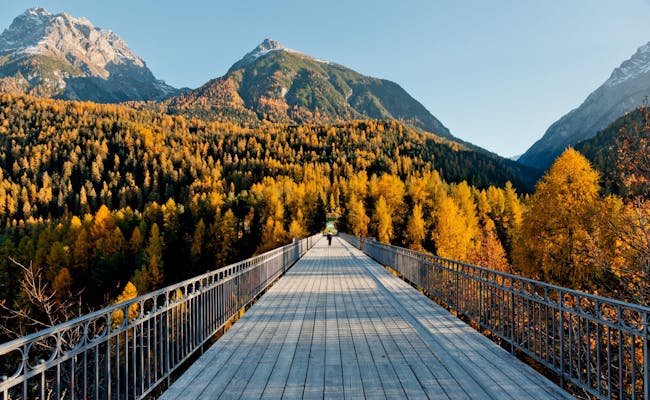

If you haven't planned today's hike yet, ask the owners of Chamanna Cluozza for their recommendations. There are plenty of other hikes with varying difficulty levels available. So, you have another day to explore the national park.
Alternatively, you can head back to Scuol right after breakfast if you've had enough hiking. The choice is entirely yours. If you're looking for a relaxing alternative, you've come to the right place in the Engadin.
On one hand, there's the thermal bath in Scuol. Depending on how sore your feet are from yesterday's hike, a few relaxing hours in the hot springs might be just what you need.
Otherwise, we suggest you visit one of the nearby villages, like Guarda or Sent. The stone houses you see there are typical for this part of Switzerland.
And when you come across those impressive buildings, keep an eye out for a bakery. The famous Engadine nut cake comes from the Engadin. If you have a sweet tooth, you definitely should try a piece or two. This cake is quite rich and heavy, but every single calorie is worth it.
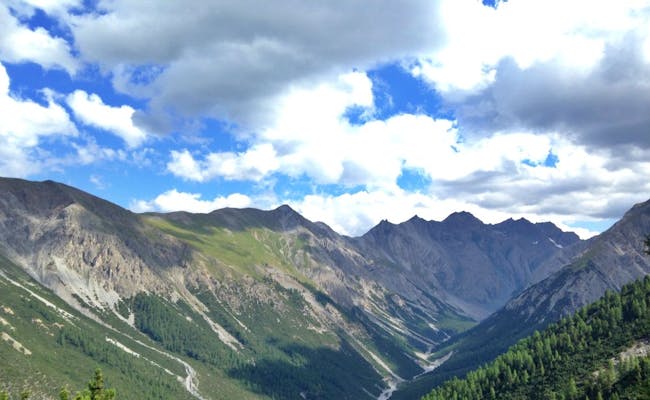

Guess what, you have another day to knock yourself out in and around Scuol today. So work on that list you’ve put together in your head. Another potentially interesting sight we haven’t mentioned yet is the castle of Tarasp.
This impressive construction near Scuol has been dominantly sitting on a steep hill since the 11th century. To see it from the inside, joining a tour is mandatory. If this is something you could see yourself doing before heading back to Zurich, check their current schedule to join a public tour.
The train ride from Scuol to Zurich takes almost three hours and unless you have a plane to catch, there’s no rush to get back.
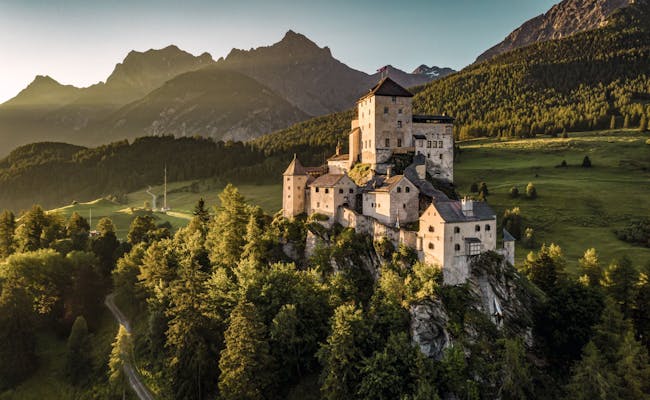

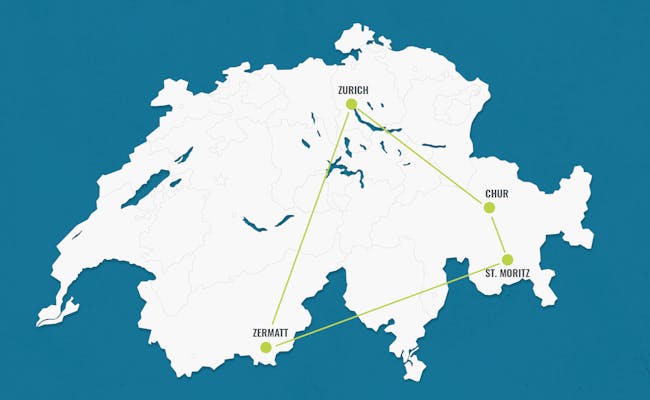
Highlights on this route:
Explore Zurich on your own in the morning, rent a free bike with "Züri rollt" or join a city tour. After the tour, you can grab a takeaway lunch and enjoy it on the train to Zermatt.
If you’re not in a rush to get to Zermatt, consider a quick stop in Bern, Spiez, or Thun. These towns are all on the way from Zurich to Zermatt and offer plenty of sights and activities.
Between Visp and Zermatt, you’ll get a first taste of what to expect on your journey with the Glacier Express. Once you arrive in Zermatt, spend the rest of the day wandering through the famous resort town and enjoying the view of the majestic Matterhorn—assuming it’s not shrouded in clouds.
In Zermatt, the mountain world and nature take center stage. If you came to Switzerland for the spectacular mountain views, you’ll love it here.
There are numerous hikes and walks of all difficulties that will take you to places you didn’t even know existed. For example, the popular Zermatt 5 Lakes Trail takes about 2.5 hours. It leads past five crystal-clear mountain lakes and offers stunning views of the Matterhorn along the way.
Another thrilling adventure, which might make you a bit dizzy, is crossing the longest pedestrian suspension bridge in the world in Randa. It spans a length of 494 m over the valley. The round trip to the bridge starts and ends in Randa, just 15 minutes by train from Zermatt.
If you’d rather skip the hike and see the mountains the easy way, we recommend taking the train up to Gornergrat. After a stunningly steep train ride, you’ll find yourself at an altitude of 3089 m above sea level, right in front of the Gorner Glacier and the Matterhorn. Don’t be surprised if you’re completely out of breath when climbing the stairs to the viewpoint; it’s not just you, it’s the thin air.
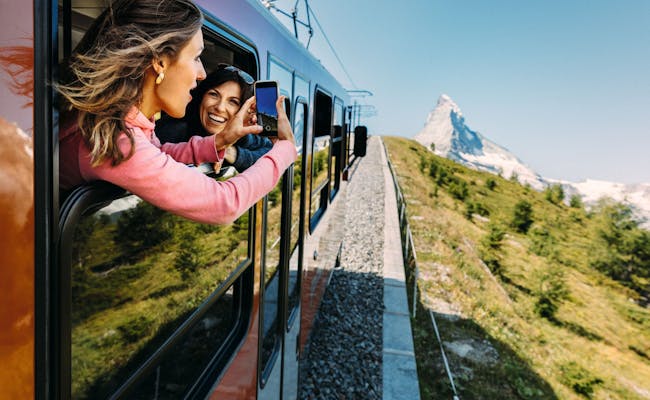

Today, you’ll take the Glacier Express from Zermatt to St. Moritz. This ride on the "slowest express train in the world" is a unique experience. Throughout the journey, you’ll be accompanied by the best views the Alps have to offer.
The train departs from Zermatt twice daily in the morning. The timetable changes throughout the year, and there are some trains that do not run the full route between Zermatt and St. Moritz. To find your connection, check the current timetable in advance.
There’s a reason why the Glacier Express is one of the most popular train routes in Switzerland. What makes this trip unforgettable are the fantastic views accompanying you throughout the ride. The train takes you over 291 bridges, through 91 tunnels, across three cantons, and two language regions.
The journey lasts a little over 8 hours, and depending on when you leave Zermatt, you’ll arrive in St. Moritz between 5:00 PM and 6:00 PM. Once you arrive, you can spend the rest of the day strolling through this chic mountain village in the Engadin.
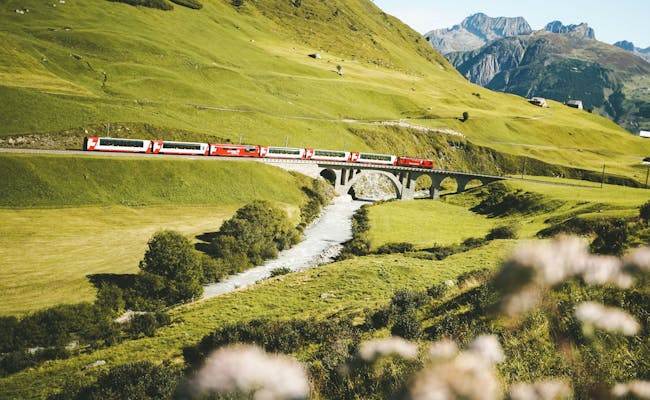

Just like in Zermatt, St. Moritz is all about outdoor adventures, whether in summer or winter. Whether you want to bike, hike, go stand-up paddling, swim, windsurf, ski, snowboard, snowshoe, cross-country ski, or simply take a walk, you can find everything your heart desires here.
Just a short drive from St. Moritz is Lake Silvaplana, a stunning spot to enjoy some of these activities.
Another must-visit place is Ospizio Bernina. At 2,253 m above sea level, this little train station is the highest point of the Bernina Express scenic train. Trains depart hourly from St. Moritz, taking you past lakes, glaciers, and towering mountain peaks.
When it comes to food, we recommend two things in Engadin. First of all, don't miss out on a bowl of Bündner barley soup. This hearty soup with barley, vegetables, and meat is a typical dish from the region and will warm you up on a chilly day like nothing else.
Secondly, treat yourself to a slice of Engadin nut cake. This rich, delicious pastry brings back all the calories you were trying to lose, but it’s definitely worth it.
Back in St. Moritz, you can spend the rest of the day strolling through the town. While St. Moritz may not be as charming and mystical as other nearby villages like Samedan or La Punt, it’s great for window shopping. And if you’re lucky, you might even spot a celebrity or two.

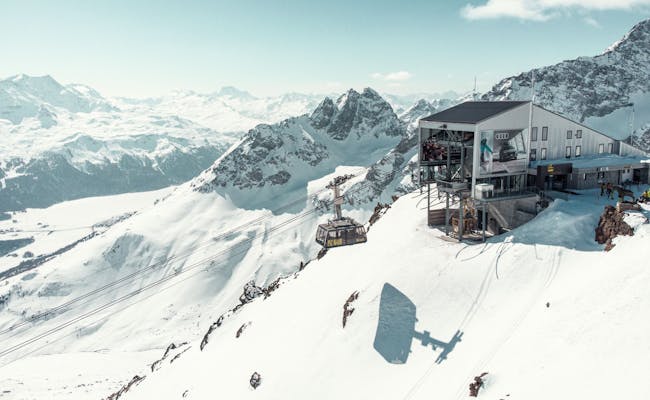
If there’s anything you didn’t get to do yesterday, today’s your chance. The train ride back to Zurich takes just over three hours so there’s no rush to leave just yet. However, if you’ve seen it all and you’re ready to move on, you’re welcome to hop on the train and spend some time anywhere along the way between St. Moritz and Zurich.
One place you might like is the dreamy village of Bergün with its impressive stone buildings that are iconic to this area. You’ll arrive in Bergün right after navigating the confusing Albula Line, the part where the train overcomes the altitude by taking a few loops and tunnels through the mountains. As you look out the window, you’ll notice the train crosses sides of the valley while spiralling down the mountains.
Another place you might enjoy between St. Moritz and Zurich is Walenstadt. Or more precisely, Lake Walensee. This beautiful lake is the perfect stopover. It’s a stunning and mystical lake and, depending on the weather and the light reflection, it sometimes reminds you of a Scottish loch.
Spend the rest of the evening in Zurich and snack on some more Engadiner Nusstorte by the lakeshore or at Lindenhof.
And this concludes our collection of five-day itineraries for Switzerland starting in Zurich. We hope you’ve been able to find the Switzerland itinerary to your taste. Have fun planning your trip.
